Sound and Digital Advertising
In the good old days sound was the main advertising medium. When walking in a park one could listen to music or news from different loudspeakers installed on lamp poles about 200 meters apart. Television was an indisputable leader at home, but streets were dominated by sound, radio broadcasting, and static outdoor advertising.
The situation has drastically changed. Static advertising slowly but surely gives way to dynamic advertising, and sound retains an important but rather secondary role in modern DOOH.
Content delivery via digital informational and advertising signage is one of the fastest growing segments in the market. By the end of 2014, North American DOOH market, the most advertising-oriented market in the world, was estimated at the level of 2.6 million displays.
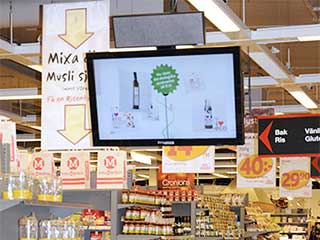 Digital signage with sound in shop
Digital signage with sound in shopConsidering that the forecasts for DOOH market deployment of displays over 26 inches in size predict stable 23% growth, the number of displays will keep growing at a fast pace. However only 2% of all outdoor displays are included in the audio broadcasting system. The recent marketing research into the audio content proves that incorporation of audio into existing video displays increases motivation of potential consumers by nearly 40%.
This may be true from the functional and commercial point of view. However the task of audio broadcasting is technically complex and requires sophisticated technical solutions. Adding audio component to outdoor advertising was bound with problems from the start.
Many in-store audio systems in malls and trade centers would inexplicably break down. Customers would be annoyed and would not want to linger longer than necessary. Ultimately, repetitive sound would drive shop assistants to distraction. As the technology matured, the situation started to improve. There are more and more displays in public areas. Consequently, there are more and more solutions related to audio channel.
Some of the most notable recent additions include expanded audio services for phone systems, voice prompts and automated attendant greetings; digital signage solutions for waiting areas broadcasting news, retail spaces and interactive kiosk applications; public space music and in-store and on-transport messaging; multimedia enhancements for the web; and custom video applications.
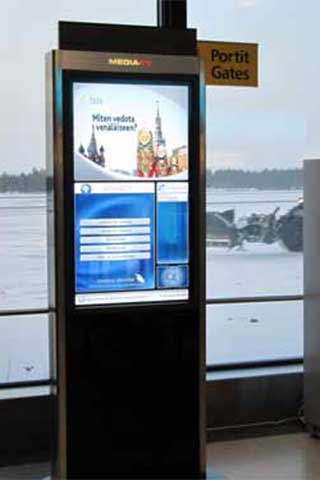 |
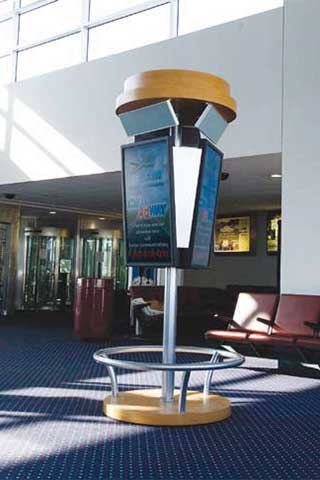 |
| Digital kiosk with sound in airport | Digital signage with sound in airport |
In fact, TV broadcasting on public displays without sound is a rather inefficient form of presenting material. How often have you seen people watching TV without sound?
This is the reason why new companies appear and offer novel applications like AudioStreamTV or HearMyLips, that allow to connect to the synchronized audio to personal portable devices. This allows people to watch the “silent” TV and listen to audio broadcast without disturbing others sitting or waiting nearby.
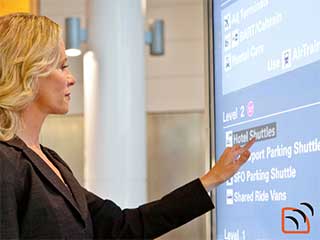 Wayfinding system with sound
Wayfinding system with soundOther companies are more optimistic in their evaluation and come up with solutions similar to HyperSound, an application that helps equip public displays with audio capabilities, including targeted zones for listening audio.
The importance of sound and its influence on human behavior frequently remains underestimated. Especially, in the commercial public space. The sound affects our mood: energetic music stimulates customers to act and buy something, soft sounds tend to relax patients who maybe waiting anxiously for the doctors visit.
It was proved that sound maybe a powerful tool in modern digital networks. Performance analysis shows that adding sound to outdoor video helps increase retail compared to video without sound.
By adding targeted audio to digital signage it is possible to raise awareness of the advertising message by nearly 10 times. Moreover, advertisers on digital screens may increase the placement price if sound is added to the video message, thus shortening the return-on-investment cycle for new digital equipment.
The companies who are aware of this (like the US-based BrightSign, for example) are developing new players capable to add to the standard play-lists various audio streams. As a result it becomes possible to add or change the accompanying music by remote commands, add audio files of different formats, integrate music or text add-ons into the existing advertising video clips.
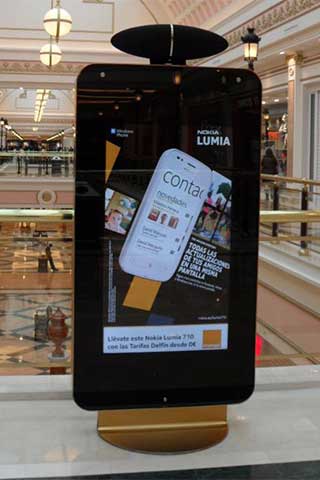 Digital totem with sound in shopping mall
Digital totem with sound in shopping mallNaturally, we should not forget that in modern noisy cities, adding sound to outdoor screens may create a cacophony and annoy people. Therefore, it is necessary to carefully consider the audio coverage zones, the distances from which we start hearing sound, correctly combine audio and video content so that they complement each other.
Neither should we forget about security measures in networks and about the possibility of remote monitoring of the events. The fact is that modern outdoor digital video systems can be used not only for commercial and advertising purposes but as Public Address Systems as well.
Thus, a standard video screen in the street is transformed from common advertising carrier into a multifunctional informational device capable to monitor public safety and environmental indices in the vicinity, to be involved in interactive communication, to turn into a loudspeaker in emergency situations.
Such multifunctional outdoor systems started appearing in Russia. They are mostly manufactured by a design and development company NAO-Pro Ltd. So far they are being installed in a limited number of cities as part of a pilot project. The aim is to turn common street digital LED screens into highly-secure TV systems. And sound in these systems is no longer a secondary and additional equipment but an important factor of public awareness and security.





